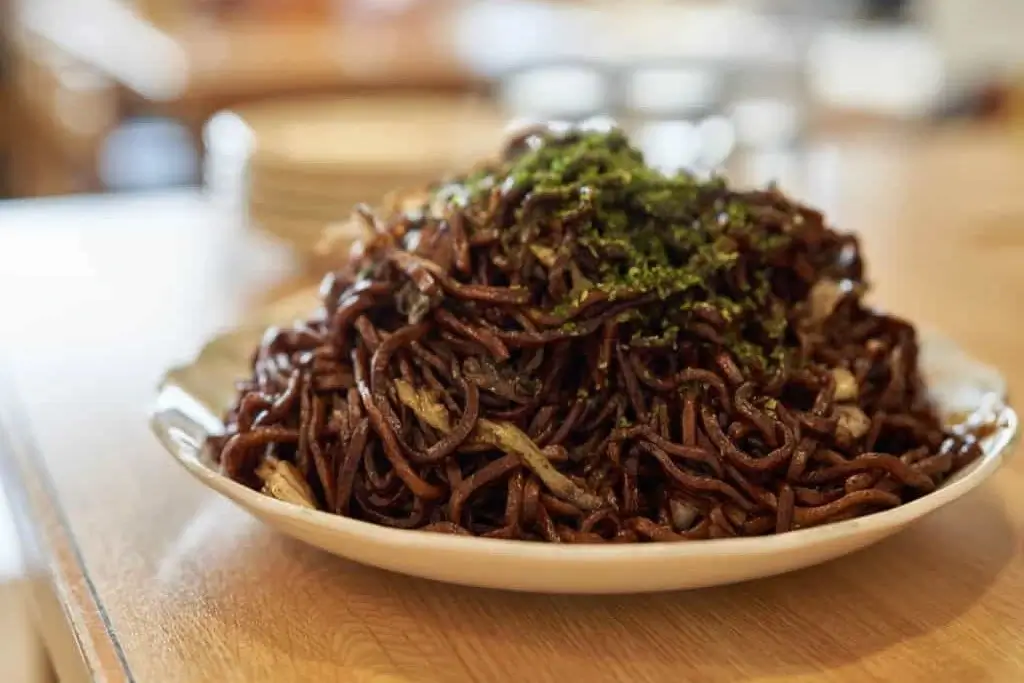Yakisoba is Japan’s favorite stir-fried noodles, and it offers a tasty journey that is full of tradition and flavor. They come in all different flavors, and people enjoy them worldwide! Let’s learn where it comes from, the different kinds, and why it’s such a loved noodle dish in Japan!
Table of Contents
ToggleWhat is the story of yakisoba?
Originating from ancient Chinese stir-fry methods, yakisoba has become a beloved Japanese dish known for its intense flavors and simple cooking style. “Yakisoba,” means “grilled noodles,” and people make it over an open flame or grill. This dish usually has Chinese-style wheat noodles stir-fried with sliced cabbage, carrots, and sometimes tender pork belly, creating a tasty mix of textures and flavors.

Over time, this noodle dish has become a big part of Japanese cooking, changing with different regional tastes. It’s prevalent everywhere, from street food stalls to home kitchens, blending simplicity and depth. Each bite also tells a story of Japanese cooking skills, mixing old and new culinary traditions. It’s also a comfort food that has turned into an art form enjoyed by many.
Yakisoba is also a large piece of Japanese culture. As people enjoy it, they also enjoy a history of food that brings together different styles and ideas from long ago. This dish is easy to love because it’s simple and tastes great. Whether you try it at a festival, a small food stall, or at home, yakisoba will surely bring a smile to your face.
Ankake

Ankake yakisoba takes yakisoba to a new level with its rich, thick sauce made from soy sauce and corn starch. This version shows how different sauces can change the flavor of yakisoba while keeping its classic stir-fried taste. People like it because they can enjoy a saucier version of this popular dish, highlighting the creativity in Japanese cooking with its delicious flavor combinations.
Shio

Shio yakisoba, famous for its delicate flavor, differs from traditional yakisoba because it uses salt (shio) as its main seasoning. This unique twist adds a fresh taste to the beloved dish. It’s perfect for those wanting a lighter yet satisfying meal. Shio yakisoba keeps the essence of stir-fried noodles. It honors tradition while taking diners on a flavorful journey. Not to mention, the dish showcases Japan’s rich food culture. It’s a delightful way to enjoy the simplicity and depth of Japanese cooking.
Are you looking for amazing snacks this summer? Check out Sakuraco! Check out Sakuraco! Sakuraco delivers traditional Japanese snacks, teas, and sweets from local Japanese makers directly to your door so you can enjoy the latest treats directly from Japan!
Oota

Oota yakisoba, which comes from Oota, has a special touch that makes it stand out: red pickled ginger. This adds a tangy zest to the dish, giving it a lively and unique flavor. This regional version shows how local ingredients can make a classic recipe even better, offering a fun twist for adventurous food lovers. It’s also a great example of the creativity and diversity in Japanese cooking. It invites people to explore the different regional dishes that Japan has to offer. Each bite of Oota yakisoba is a chance to taste the unique and exciting flavors that make Japan’s culinary traditions rich and varied.
Sobameshi
Sobameshi is a popular fusion dish that combines yakisoba noodles with fried rice. This hearty meal satisfyes both noodles and rice cravings in every bite. This creative twist shows how versatile yakisoba can be, blending seamlessly with traditional staples to create exciting new flavors.

This dish allows people to enjoy the best of both worlds by combining the robust flavors of stir-fried noodles with the comforting texture of fried rice. This dish exemplifies the dynamic evolution of Japanese cuisine, offering a delicious and innovative dining experience.
Fujinomiya

Named after the scenic town near Mount Fuji, Fujinomiya yakisoba is unique because it uses soba noodles instead of the usual Chinese-style wheat noodles. These soba noodles have a nutty flavor and a chewy texture, giving the dish a delightful twist that matches local tastes. Fujinomiya yakisoba highlights regional creativity, offering a tasty way to explore Japan’s rich culinary diversity. It showcases how local ingredients and preferences can create unique and delicious dishes.
Why is yakisoba such a versatile dish?
Yakisoba’s appeal lies in its ability to satisfy various tastes and preferences. Its simple preparation makes it accessible to home cooks and professional chefs, encouraging endless creativity in the kitchen. From its origins as a street food favorite to its cherished place at festivals and gatherings, yakisoba continues to captivate food enthusiasts worldwide. Its popularity reflects its power to unite people through shared culinary experiences, celebrating the artistry of Japanese stir-fried cuisine.

Next time you’re craving a taste of Japan, consider exploring the world of these delicious noodles and discovering why they remain a timeless favorite among food lovers everywhere. Have you tried yakisoba, or are you curious about its tasty varieties? Share your thoughts and experiences with us in the comments below—we’d love to hear from you!











